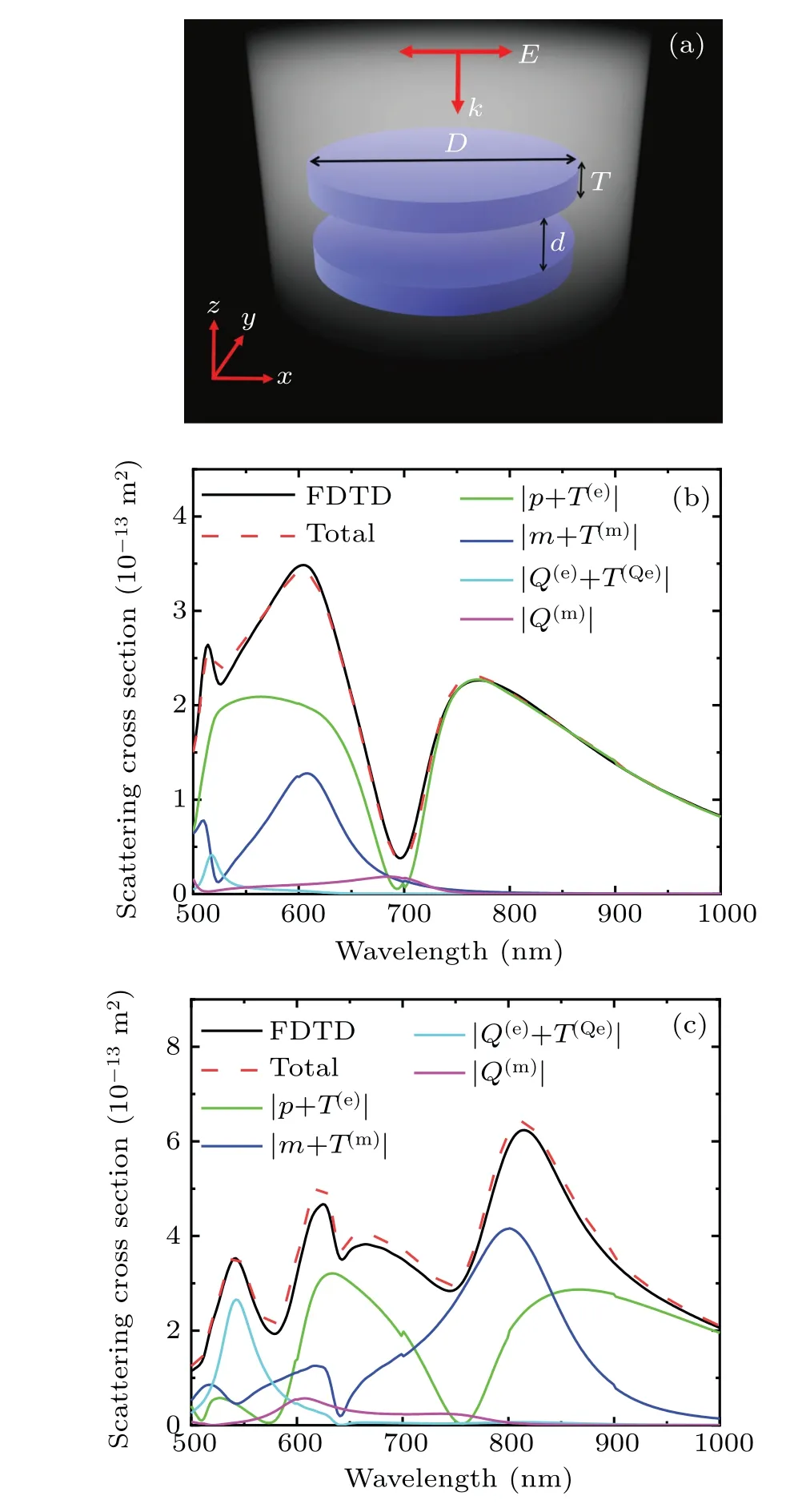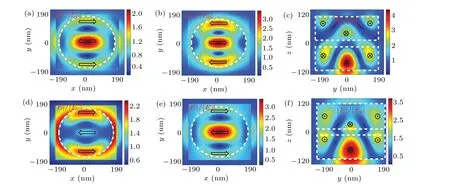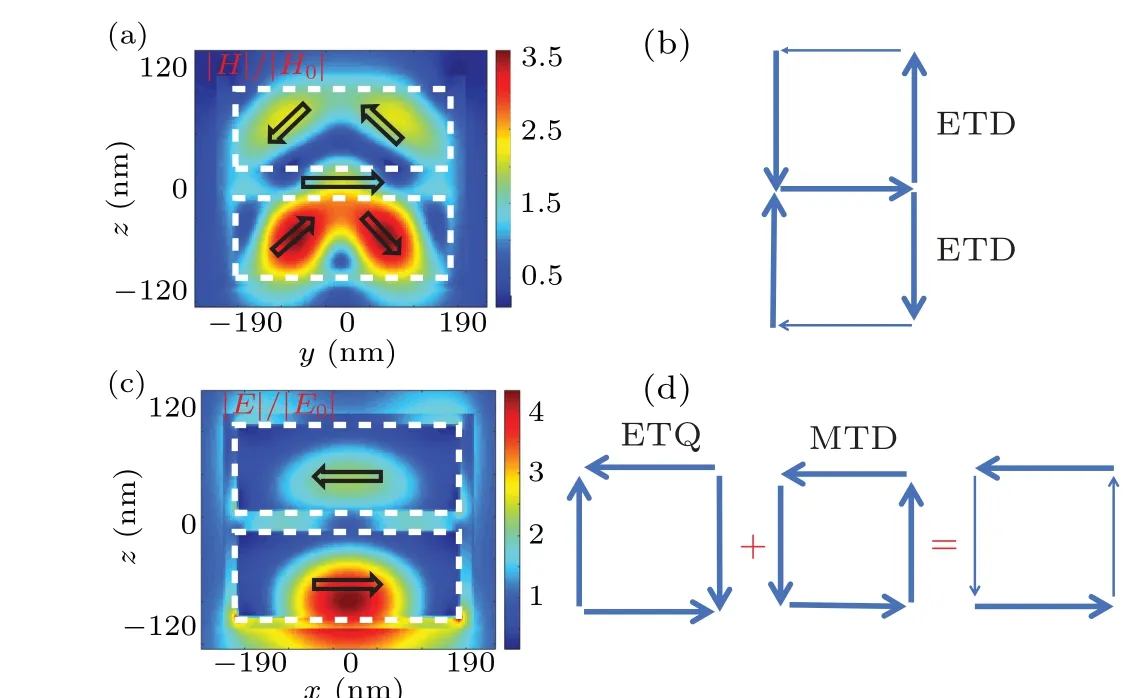Strong near-field couplings of anapole modes and formation of higher-order electromagnetic modes in stacked all-dielectric nanodisks
Bin Liu(刘彬) Ma-Long Hu(胡马龙) Yi-Wen Zhang(章艺文) Yue You(游悦)Zhao-Guo Liang(梁钊国) Xiao-Niu Peng(彭小牛) and Zhong-Jian Yang(杨中见)
1Hubei Key Laboratory of Ferroelectric and Dielectric Materials and Devices,Faculty of Physics and Electronic Science,Hubei University,Wuhan 430062,China
2Hunan Key Laboratory of Nanophotonics and Devices,School of Physics and Electronics,Central South University,Changsha 410083,China
Keywords: all-dielectric nanodisks,anapole,electric toroidal dipole,magnetic toroidal dipole
1. Introduction
Much progress has recently been made in nanophotonics research and development with applications in metasurfaces,[1,2]nonlinear optics,[3,4]and nano-antennas.[5,6]Plasmonic nanostructures have played an essential part in these sub-fields. Plasmonic nanostructures mainly support electric dipole(ED)and electric multipole modes.[7]However,the material losses of plasmonic structures are usually high.Recently, all-dielectric nanostructures with low material loss have become another important branch of nanophotonics.[8,9]In all-dielectric nanostructures, electric and magnetic resonance modes can be readily excited in simple structures.These electromagnetic resonances of dielectric structures are of fundamental importance for their applications. The typical electric and magnetic dipole or higher-order modes can further interact, providing new routes to adjust the optical responses of dielectric nanostructures. Many relevant optical phenomena have been reported,including the electric/magnetic dipole mode hybridization[10]and Fano resonance.[11–13]
In addition to the standard dipole and multipole electromagnetic modes, nonradiating electromagnetic states in all-dielectric nanostructures have recently attracted many research interests.[14–18]These new nanophotonic modes include anapole modes, where an electric anapole is induced by the coherent combination of an electric dipole and an electric toroidal dipole (TD) moment.[15]An ETD mode can be regarded as a higher-order term of the electric dipole expression in the Cartesian multipole decomposition method.[19–21]The toroidal multipole and the electric dipole have the same radiation pattern, but their current configurations are different. The electric anapole has been widely investigated in many aspects of nanophotonics, such as local field enhancement,[22–25]nonlinear optical effects,[26–29]photon–exciton coupling,[30,31]hybrid dielectric-plasmonic antennas,[32–34]and metamaterials.[35]Similar to the ETD mode, the magnetic toroidal dipole (MTD) has also been studied. MTD can be formed by a closed loop of the ETD moments.[20,36–38]MTD and the magnetic dipole (MD) can form a magnetic anapole mode.
Here, we show that the electric anapole modes can be strongly coupled through nearfield interactions. The structure consists of stacked all-dielectric nanodisks,where the two silicon (Si) nanodisks are the same. The ETD modes of the anapoles of the two disks can form bonding and anti-bonding hybridized modes. A new electric anapole mode of the whole dimer is found due to the interference between the bonding hybridized ETD and ED modes. It is also found that the antibonding hybridization of the ETD modes can induce an MTD response of the disk dimer. The MTD and MD resonances of the dimer will lead to a magnetic anapole mode. Thus,two dips associated with the hybridized modes appear on the scattering spectrum of the dimer. The MTD resonance is also accompanied by the electric toroidal quadruple (ETQ) mode.Multipole expansions and near-field distributions will be calculated to identify the higher-order electromagnetic mode responses. The hybridizations of the ETDs and the formatted higher-order modes can be tuned by varying the geometries of the disks.
2. Results and discussion
Figure 1(a) shows the structure’s schematic, where the polarization and wave vector of the excitation plane wave is along thex-axis andz-axis,respectively.

Fig. 1. (a) Schematic illustration of two stacked Si nanodisks with an xpolarized plane wave excitation. The distance between the nanodisks is d.The origin of the coordinate system is placed at the center of the structure.(b)and(c)The scattering spectrum of an individual Si nanodisk(b)and the stacked nanodisks (c). The contributions from different multipole modes are also shown. They are integrated ED and ETD mode (|p+T(e)|), integrated MD and MTD mode (|m+T(m)|), integrated EQ and ETQ mode(|Q(e)+T(Qe)|),and the magnetic quadrupole(MQ)mode(|Q(m)|).
Crystalline Si is chosen as the material for the structure,and the dielectric constants are taken from Palik’s book.[39]The index of the surrounding medium is 1. The simulations were carried out by using commercial finite-difference timedomain (FDTD) software (Lumerical FDTD). The Cartesian multipole decomposition method was used to calculate further the contribution of different multipole modes to the scattering spectrum. The Cartesian multipoles include ED,MD,electric quadrupole(EQ),magnetic quadrupole(MQ),ETD and MTD,where these vectors in Fig.1 are denoted byP,m,Q(e),Q(m),T(e)andT(m), respectively. The diameterDand thicknessTof each Si disk are 300 nm and 80 nm,respectively. The scattering spectrum of an individual disk is shown in Fig. 1(b).The sum of the contributions of different multipole modes is in good agreement with the results of the direct FDTD calculation of the scattering spectrum(Fig.1(b)),which means that the contribution of higher-order modes can be ignored.
The dip on the scattering spectrum(~700 nm)of the individual disk is an electric anapole mode induced by the destructive interference of the ED and ETD responses. The scattering spectrum of the stacked Si nanodisks is shown in Fig. 1(c).There are two apparent dips at the wavelengths ofλ=640 nm andλ=760 nm. The appearance of two dips indicates the strong coupling between the two nanodisks.Multipole decomposition results show that at the wavelengths ofλ=760 nm,the main contributions to the spectral responses are the integrated ED and ETD modes (|p+T(e)|), and the spectral behavior is similar to the anapole mode of the individual disk.The dip atλ=64 nm mainly comes from the integrated MD and MTD modes(|m+T(m)|). In addition,there are also contributions of integrated EQ and ETQ modes (|Q(e)+T(Qe)|)and the magnetic quadrupole(MQ)mode(|Q(m)|).
We calculated the electromagnetic near-field distributions to gain further insight into the electromagnetic interactions at the two dips of the scattering spectrum. Figures 2(a)and 2(b)show the electric field enhancement and direction of the upper and lower disks. The wavelength isλ=640 nm, which corresponds to the first dip position of the scattering spectrum.The electric field loops appear on each disk,which correspond to the ETD moments. However,the two ETD moments show opposite directions,where the loops show opposite rotating directions.This corresponds to the anti-bonding hybridization of the two ETD moments,which is similar to the hybridizations of electric dipoles.[7]Figure 2(c) shows the electric field enhancement and directions on thex=0 plane. The wavelength is alsoλ=640 nm. The field distribution also confirms the existence of the ETD hybridization at this wavelength. Figures 2(d)–2(f) show the electric field enhancement and the field directions at the wavelength ofλ=760 nm, which is another dip of the scattering spectrum. The ETD moments can also be found on the disks, although they show the same direction,indicating bonding hybridization occurs. The bonding hybridization of the ETD moments forms a new ETD moment of the dimer. This new ETD can interact with the ED moment of the dimer and induce an anapole mode of the dimer atλ=760 nm.

Fig.2. Hybridization of the ETD modes. (a) and(b)Electric field enhancement of the upper(a)and lower(b)disks of the dimer structure. The wavelength is λ =640 nm. The arrows show the electric field directions. (c)Electric field enhancement and directions on the x=0 plane of the dimer structure at λ =640 nm. (d)and(e)Electric field enhancement of the upper(d)and lower(e)disks of the dimer structure. The wavelength is λ =760 nm. The arrows show the electric field directions. (f)Electric field enhancement and directions on the x=0 plane at λ =760 nm.

Fig.3. (a)Magnetic field enhancements on the x=0 plane of the disk dimer at λ =640 nm. The arrows show the magnetic directions. (b)Schematic illustration of the MD moments associated with the formation of MTD.(c)Electric field enhancement and the field directions on the y=0 plane at λ =640 nm. (d) Schematic illustration of the ETD moments associated with the combined ETQ and MTD modes.
The dip feature atλ=640 nm is mainly induced by the magnetic response, as shown in Fig.1(c). This indicates that there may be a magnetic anapole mode here.This is confirmed by the magnetic field distribution on thex=0 plane(Figs.3(a)and 3(b)). Each disk shows two main MD moments with opposite directions, which is associated with the ETD response of the disk. There is another MD moment in between the two disks. These MD moments form an MTD response, where a similar situation can be found in other structures.[38]It is noted that the MD moments of the disks are associated with the antibonding hybridization of the ETD moments of the two disks.This MTD will destructively interfere with the original MD response of the dimer and induce the magnetic anapole resonance. In addition to the MTD response, the EQ part also shows a dip feature atλ=640 nm(Fig.1(d)). Nearfield distribution results show that this is closely related to MTD response(Figs.3(c)and 3(d)). Each disk has an ETD moment,while MTD formation requires a closed loop of the ETD moments,implying there should also be an ETD moment between the disks to form a perfect MTD.However,this is not the case,as shown by Fig. 3(c). Thus, ETQ is also excited, and the combination of MTD and ETQ will cancel the ETD moment between the two disks.
The hybridizations of the disk’s ETDs and the MTD response can be largely turned by varying the geometries of the dimer.Figure 4(a)shows the calculated scattering spectra with the surface distance d between the disks from 0 nm to 40 nm,where the other parameters are the same as that in Fig.1. As the distance decreases,the hybridization of the ETDs becomes stronger. This change will induce redshift (blueshift) of the bonding (anti-bonding) dip. Similar phenomena have been well known in ED and MD systems.[10,40]As to the response dip feature,the stronger bonding response induces a more pronounced dip associated with the electric anapole mode. On the other hand,the stronger anti-bonding coupling reduces the MTD response and the corresponding dip feature associated with the magnetic anapole mode. We also consider the influence of thicknessTon the ETD hybridization (Fig. 4(b)). It can be easily checked that the anapole mode of an individual disk redshifts with the thickness. Thus, both dips associated with the hybridized modes redshift with the thickness.The dip of the magnetic anapole mode becomes relatively weaker with the thicknessT. This is because the MD mode of the dimer redshifts faster than MTD withT, and the multipole expansion calculations can confirm the overlapped part of the MD mode becomes weaker.

Fig.4. (a)Scattering spectra of stacked disks with different surface distance d (0–40 nm). Each disk is the same as in Fig. 1. (b) Scattering spectra of stacked disks with different thickness T (60–90 nm). The radius of each disk is 150 nm,and the surface distance is 20 nm.
3. Conclusion and perspectives
In conclusion,we demonstrated that strong hybridizations of the ETD modes can occur in all-dielectric stacked disks.Each disk holds an electric anapole mode formed by combining an ED and an ETD mode. The anti-bonding hybridization of the ETD modes can form an MTD mode in the disk dimer.The MTD will cause interference with the dimer’s magnetic dipole mode and form a magnetic anapole mode. We also performed multipole expansion and near-field distribution calculations to identify the electromagnetic responses. The MTD mode can be adjusted by changing the geometry of the disk dimer.The strong ETD hybridizations and the associated electromagnetic responses in simple dielectric nanostructures provide a rich optical manipulation platform for nanoscale electric and magnetic fields. They may also find applications in fields such as nanoantennas,metasurfaces and metamaterials.
Acknowledgements
Project supported by the National Natural Science Foundation of China (Grant Nos. 11704416 and 11704107), the Hunan Provincial Natural Science Foundation of China(Grant No.2021JJ20076), and the Hubei Provincial Natural Science Foundation of China(Grant No.2020CFB557).
- Chinese Physics B的其它文章
- Erratum to“Boundary layer flow and heat transfer of a Casson fluid past a symmetric porous wedge with surface heat flux”
- Erratum to“Accurate GW0 band gaps and their phonon-induced renormalization in solids”
- A novel method for identifying influential nodes in complex networks based on gravity model
- Voter model on adaptive networks
- A novel car-following model by sharing cooperative information transmission delayed effect under V2X environment and its additional energy consumption
- GeSn(0.524 eV)single-junction thermophotovoltaic cells based on the device transport model

